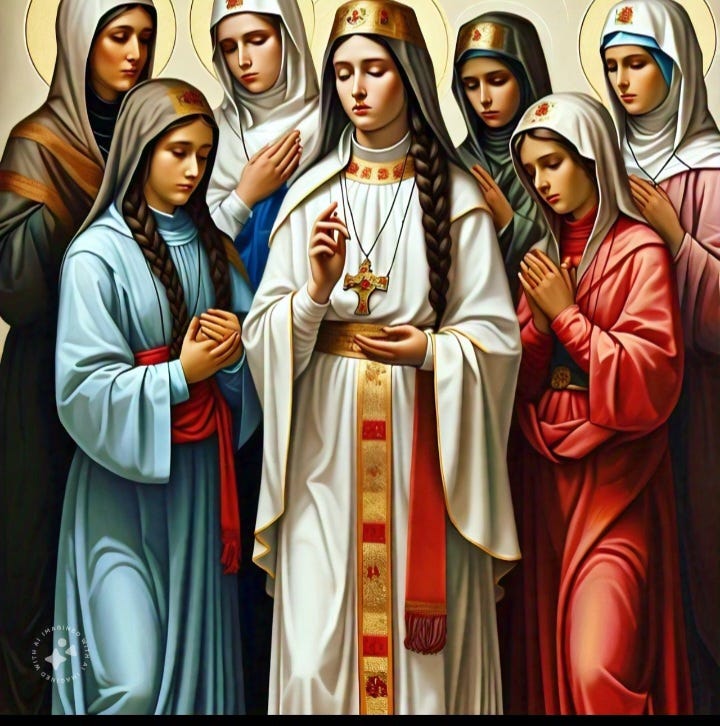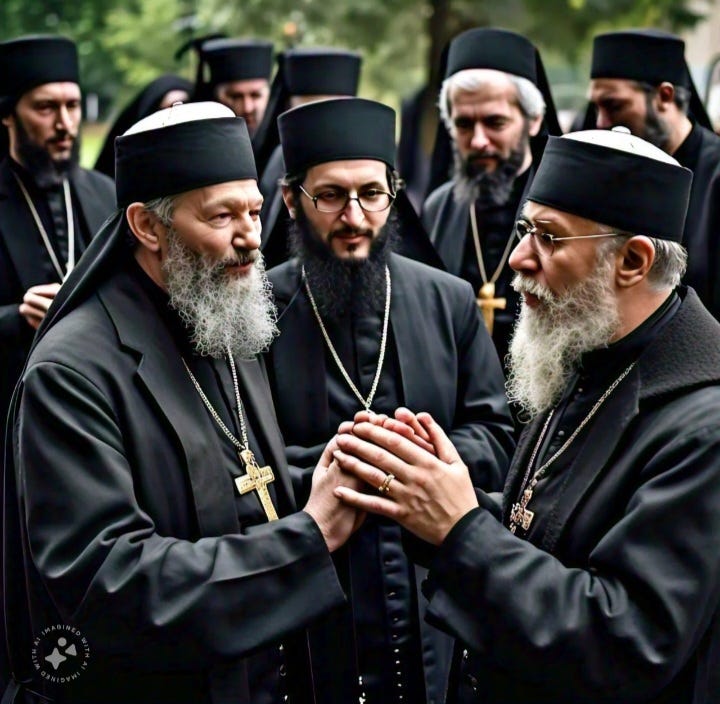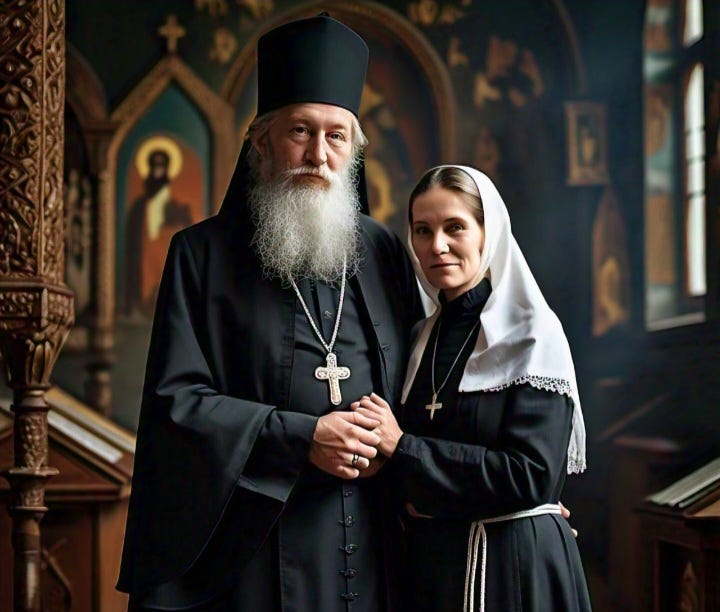Why Orthodox Priests Should Be Men
Understanding the Symbolic and Theological Foundations
Introduction and disclaimer: I am approaching this topic as a layperson with admittedly limited experience and knowledge. My experience consists of being a member of the Orthodox Church for less than two years and attending Orthodox services for about four years. My knowledge consists of reading several books about orthodoxy over the past four years, attending study groups at my church, going through catechumen education before becoming baptized into the church, and conducting specific research for this essay. I am neither a theologian nor any authority on church doctrine. This essay is based on my own experiences in the church and my limited understanding of church theology and doctrine. I apologize in advance for any incorrect or inaccurate interpretations. If you notice any inaccuracies in the information presented, please leave a comment. The last thing I want to do is spread incorrect information about the church.
In this essay, I present the argument that priests in the Orthodox Church should be men. Women should not be priests. I further posit that this is not sexist and that the church as a whole is not sexist despite the spiritual leadership being male.
In church services, the priest represents Christ, who was the first priest. Christ passed on His priestly duties to His Apostles. From the Apostles, the duties of the priest were passed on through an unbroken chain to our current priests. This is known as the Apostolic succession and is an important aspect of the church. (St. Barbara Greek Orthodox Church, n.d.) Because the priest represents Christ in church services, it makes sense that he should be male because Christ was male. Men and women have different attributes, and for Christ to be represented by a woman would be symbolically incorrect.
I should point out here the importance of symbolism in the Orthodox Church. Symbols in the church represent the presence of God. And that is putting it mildly. It is more like a door through which one can experience the divine. Icons (images of divine figures or scenes, often painted on wood or other materials) are one of the more important symbols in the church. An icon is more than just an image of a holy figure. It is a window that gives us a peek into the world of the spiritual and a connection with the sacred individual or scene pictured.
That is why Orthodox Christians venerate icons. They are venerating the divinity in the image pictured, not the image itself—not the wood and paint that make the image, but the holiness of the person or scene pictured. Likewise, people, made in the image of God, are called upon to be icons of God. (Patheos, n.d.) During church services, the priest is an icon of Christ. He is a window into the divine nature of Christ. It would not make sense for a woman to have this role as Christ was not a woman.
The church is often referred to as the “Bride of Christ,” giving the congregation a feminine quality. (My Parish, Bulletin of the Diocese of Mount Lebanon, 2009) During services, the congregation (led by the choir) participates through hymns, chanting, and prayers. There is a constant back and forth between the chanting, prayers, and declarations of the priest (and deacons, readers, etc.) and the chanting, prayers, and singing of the congregation. This back-and-forth mutual participation and communication is reminiscent of the back-and-forth communication of a husband and wife (Christ and His Bride).
This is the symbology of Christ communicating with His Bride in action. With this symbology, it again makes sense for the priest to be a man as he represents Christ. Of course, the congregation is made up of both men and women, but biblically speaking, the church congregation as a whole is considered the Bride of Christ and therefore feminine even though it includes men.
Another factor to consider is that God is thought of as a father figure. God is referred to as “Father” many times in the Bible. (Jordan, 2024) Likewise, priests are referred to as “Father.” As God’s representatives on earth, it makes sense symbolically that priests would be men and have a fatherly role toward their congregation. In a family, there are differences between the role of a father and the role of a mother. (Piper, 2008)
The father is traditionally the leader, the disciplinarian, the encourager of independence and responsibility, the provider, and the protector. The mother is traditionally the caregiver, the comforter, the provider of emotional support, the provider of early education, and the homemaker. In the Church, the priest represents the father in the church family. And this lines up appropriately with God being portrayed as a father figure.
What are some specific ways that the priest enacts the role of father figure to his congregation? Here is a list that corresponds with the traditional attributes of a father:
-Leader: The priest is the head of the church. He leads all the major services, and his approval is required for the implementation of new programs or services at the church. He also leads by example by being an exemplary Christian.
-Disciplinarian: When we sin, we confess with the priest as witness and are provided guidance for redemption and forgiveness.
-Encourager: He encourages us to take responsibility for our sins through confession and repentance. He may encourage individuals to take responsibility for their spiritual growth by suggesting specific actions (e.g., prayer, fasting, church attendance, church participation, etc.). He counsels his members on their specific circumstances, suggesting the most Christlike way to approach a situation. Independence is promoted by encouraging church members to take the lead in arranging groups and activities, like Bible studies, church outings, etc.
-Provider: Priests are providers in the sense that they provide all the services that the role of priest entails: overseeing confessions, counseling, offering spiritual guidance, leading services, and leading the church as a whole.
-Protector: The priest protects his congregation spiritually by offering the opportunity for confession and redemption, offering blessings and prayers, providing spiritual guidance, and perhaps most importantly, serving communion. The priest is also someone who can provide guidance and suggest resources to members in serious trouble, such as a domestic violence situation or other dangerous situations.
So, if the priest represents the father in the church family, who represents the mother? I think this depends on the individual parish. In parishes with a married priest (the Orthodox Church allows married priests), sometimes the wife of the priest plays a motherly role toward the congregation. In the Russian tradition, even the title for a priest’s wife is “Matushka,” which means “little mother.” (Freeman, 2015) In parishes with an unmarried priest, there is often a woman or multiple women in the congregation who take on this type of role. This is the case in my own parish. These are often women who serve on the church board and have a particularly vested interest in the church community.
Some specific ways the priest’s wife or members of the congregation may take on a motherly role toward parishioners include:
(For brevity, I will specifically refer to the priest’s wife in this list, but know I am also referring to members of the congregation who take on a motherly role.)
-Caregiver: When a member is sick, or when a family has a baby, the priest’s wife rallies the congregation to provide meals and other support.
-Emotional Supporter/Comforter: She may provide emotional support and comfort for grieving or struggling members. She may also provide comfort and counseling to women on family issues.
-Provider of Early Childhood Education: The priest’s wife may lead Sunday School classes, providing children with early moral and spiritual guidance. (Strelkova, 2021)
-Homemaker: In the context of the church, the priest’s wife may assist with cleaning, decorating, and organizing the church, or she may be responsible for delegating these duties.
The position of the church board is another point that warrants mention. The church board (or church council) oversees the administrative functions of each individual church, such as church finances, maintenance, fundraising, community outreach, event planning, compliance with local laws, etc. Women are allowed to serve on the church board, even in the position of president (as is currently the case at my church). I want to emphasize this because it shows that women can serve in influential and powerful roles within the church even though they cannot be priests.
One important way that the church elevates women is the veneration of Mary. In the church I attend, the largest icon in the building is a depiction of Mary with the Christ child painted on the dome above the altar. She as the Mother of Christ is the second most important person in Orthodox Christian doctrine after Christ Himself. Her importance in the church symbolizes the importance and value the church places on women and mothers. (Berzonsky, 2005)

The church also venerates the many, many female saints that have existed throughout church history. Several female saints are so highly revered that they have been bestowed with the title of Equal to the Apostles. One of these is Saint Mary Magdalene. Saint Mary Magdalene is also sometimes called the Apostle to the Apostles because she was the first person to witness the resurrected Christ. (Believers Eastern Church, n.d.)
In addition, I would argue that in Orthodox Christianity, Christ is held up to be the ideal man and His Mother Mary, the ideal woman. These are the examples we should strive for. Some traits of Christ that make Him the ideal man include expressing boundless self-sacrificial love and compassion for His family (which are all God’s children), acting with humility, leading by serving others, sharing his wisdom, offering forgiveness and mercy, acting with courage and integrity, and remaining faithful to God’s will. Also, when required, He is bold, fearless, offensive, challenging, passionate, and not afraid of hard work. (Men of Grit, 2020)
Some of the traits that make Mary the ideal woman include unwavering faith in God, unquestioning obedience to God’s will, embracing humility, acting with deep compassion and maternal care, demonstrating purity and chastity (this could also be interpreted as self-control), exuding strength, practicing perseverance, acting courageously, and dedicating herself to prayerful devotion to God. (Schleicher, 2014) There is much overlap, but also some minor differences. Ultimately, as Christians, we are all called to be like Christ. Mary, being His Mother, was certainly Christlike but in the most feminine version of that frame.
In summary, the Orthodox Church has legitimate reasons to require priests to be men that have nothing to do with sexism and everything to do with symbology. During church services, the priest symbolizes Christ, who was a man. The church also represents a family and in a traditional family, the roles of the father and the mother are different. The priest is in the best position both symbolically and practically to serve as the father figure. Often the priest’s wife or certain members of the congregation serve as mother figures.
The Orthodox Church is not sexist as a whole because women are allowed leadership roles in church administration, Mary is deeply respected and venerated as the second most important person in Christian theology after Christ, and many female saints are so respected that they are elevated to the point of being Equal to the Apostles. Additionally, in the Orthodox Church, we are given spiritual role models for both genders: We look up to Christ as the role model for the ideal man and Mary as the example of the ideal woman.
Bibliography
Believers Eastern Church. (n.d.). Mary Magdalene, Apostle to the Apostles. Retrieved from Believers Eastern Church: https://www.bec.org/mary-magdalene-apostle-to-the-apostles/
Berzonsky, F. V. (2005, March 20). Theotokos and the Mother of God. Retrieved from Orthodox Church in America: https://www.oca.org/reflections/berzonsky/theotokos-and-the-mother-of-god
Freeman, F. S. (2015, October 8). The Priest's Wife. Retrieved from Glory To God For All Things: https://glory2godforallthings.com/2015/10/08/the-priests-wife/
Jordan, J. M. (2024). How many times is Father mentioned in the Bible? (What is a father according to the Bible, Biblical references about Father + Bible verses about Father). Retrieved from Christian Faith Guide: https://christianfaithguide.com/how-many-times-is-father-mentioned-in-the-bible/
Men of Grit. (2020, June 15). The Rugged Man’s Perspective of the Other Side of Jesus. Retrieved from Men of Grit: https://menofgrit.blog/the-rugged-mans-perspective-of-jesus/
My Parish, Bulletin of the Diocese of Mount Lebanon. (2009, March 6). The Church is the bride of Christ. Retrieved from Orthodox Online Network: https://www.orthodoxonline.org/theology/en/faith-and-theology/the-holy-church/church-the-bride-of-christ/
Patheos. (n.d.). Religion Library, Eastern Orthodoxy. Retrieved from Patheos: https://www.patheos.com/library/eastern-orthodoxy/ritual-worship-devotion-symbolism/symbolism
Piper, J. (2008, October 3). Do Fathers and Mothers Have Different Roles In Parenting? Retrieved from Desiring God: https://www.desiringgod.org/interviews/do-fathers-and-mothers-have-different-roles-in-parenting
Schleicher, L. (2014, December 4). The feminine strength of Mary, Mother of God. Retrieved from FemCatholic: https://www.femcatholic.com/post/the-feminine-strength-of-mary-mother-of-god
St. Barbara Greek Orthodox Church. (n.d.). Priesthood. Retrieved from St. Barbara Orthodox Church: https://www.saintbarbara.org/our_faith/seven-sacraments/priesthood
Strelkova, O. (2021, November 2). Married to a Priest: What is it Like? Retrieved from Orthodox Christianity: https://orthochristian.com/142696.html




All very reasonable.
But coming from a protestant background, to Orthodoxy, I take a much more pragmatic view of it: when women run the church, men stop being interested. When men run the church, women still come to church. We need everybody in church, so men need to run the church. Case closed. It's not an accident that we're pretty much the only church that doesn't have an overwhelming imbalance of women/men.
I'm sure there's more that applies, that there are theological, symbolic, and maybe esoteric layers to it. But that one reason is good enough for me. As a woman, I don't want to go to a church run entirely by women (been there done that, it sucks), and the only way to keep that from happening, is to make sure the top job always goes to a man. It's not foolproof, sometimes you end up with a weak man and the women take over anyway. But on the balance it works pretty well.